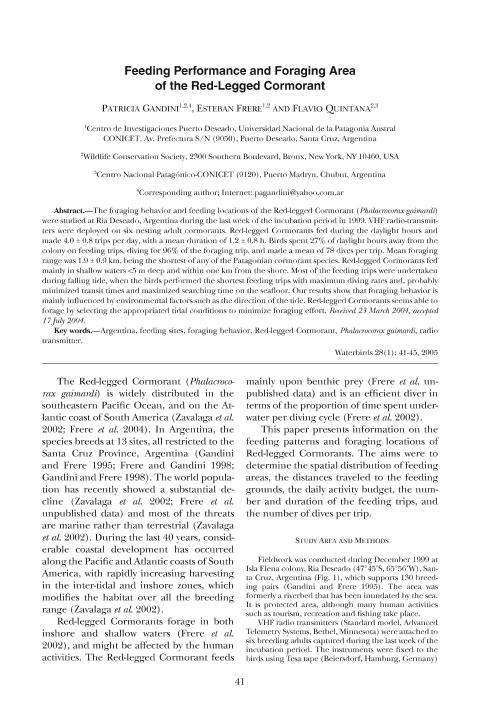Mostrar el registro sencillo del ítem
dc.contributor.author
Gandini, Patricia Alejandra

dc.contributor.author
Frere, Esteban

dc.contributor.author
Quintana, Flavio Roberto

dc.date.available
2020-05-19T20:19:54Z
dc.date.issued
2005-03
dc.identifier.citation
Gandini, Patricia Alejandra; Frere, Esteban; Quintana, Flavio Roberto; Feeding Performance and Foraging Area of the Red-Legged Cormorant; Waterbird Society; Waterbirds; 28; 1; 3-2005; 41-45
dc.identifier.issn
1524-4695
dc.identifier.uri
http://hdl.handle.net/11336/105498
dc.description.abstract
The foraging behavior and feeding locations of the Red-legged Cormorant (Phalacrocorax gaimardi) were studied at Ria Deseado, Argentina during the last week of the incubation period in 1999. VHF radio-transmitters were deployed on six nesting adult cormorants. Red-legged Cormorants fed during the daylight hours and made 4.0 ± 0.8 trips per day, with a mean duration of 1.2 ± 0.8 h. Birds spent 27% of daylight hours away from the colony on feeding trips, diving for 96% of the foraging trip, and made a mean of 78 dives per trip. Mean foraging range was 1.9 ± 0.9 km, being the shortest of any of the Patagonian cormorant species. Red-legged Cormorants fed mainly in shallow waters <5 m deep and within one km from the shore. Most of the feeding trips were undertaken during falling tide, when the birds performed the shortest feeding trips with maximum diving rates and, probably minimized transit times and maximized searching time on the seafloor. Our results show that foraging behavior is mainly influenced by environmental factors such as the direction of the tide. Red-legged Cormorants seems able to forage by selecting the appropriated tidal conditions to minimize foraging effort.
dc.format
application/pdf
dc.language.iso
eng
dc.publisher
Waterbird Society

dc.rights
info:eu-repo/semantics/openAccess
dc.rights.uri
https://creativecommons.org/licenses/by-nc-sa/2.5/ar/
dc.subject
ARGENTINA
dc.subject
FEEDING SITES
dc.subject
FORAGING BEHAVIOR
dc.subject
RED-LEGGED CORMORANT
dc.subject.classification
Ecología

dc.subject.classification
Ciencias Biológicas

dc.subject.classification
CIENCIAS NATURALES Y EXACTAS

dc.title
Feeding Performance and Foraging Area of the Red-Legged Cormorant
dc.type
info:eu-repo/semantics/article
dc.type
info:ar-repo/semantics/artículo
dc.type
info:eu-repo/semantics/publishedVersion
dc.date.updated
2020-05-15T15:55:11Z
dc.journal.volume
28
dc.journal.number
1
dc.journal.pagination
41-45
dc.journal.pais
Estados Unidos

dc.journal.ciudad
Florida
dc.description.fil
Fil: Gandini, Patricia Alejandra. Universidad Nacional de la Patagonia Austral. Unidad Académica Caleta Olivia. Centro de Investigaciones Puerto Deseado; Argentina. Wildlife Conservation Society; Estados Unidos. Consejo Nacional de Investigaciones Científicas y Técnicas; Argentina
dc.description.fil
Fil: Frere, Esteban. Wildlife Conservation Society; Estados Unidos. Consejo Nacional de Investigaciones Científicas y Técnicas; Argentina. Universidad Nacional de la Patagonia Austral. Unidad Académica Caleta Olivia. Centro de Investigaciones Puerto Deseado; Argentina
dc.description.fil
Fil: Quintana, Flavio Roberto. Wildlife Conservation Society; Estados Unidos. Consejo Nacional de Investigaciones Científicas y Técnicas. Centro Científico Tecnológico Conicet - Centro Nacional Patagónico; Argentina
dc.journal.title
Waterbirds

dc.relation.alternativeid
info:eu-repo/semantics/altIdentifier/doi/https://doi.org/10.1675/1524-4695(2005)028[0041:FPAFAO]2.0.CO;2
dc.relation.alternativeid
info:eu-repo/semantics/altIdentifier/url/https://bioone.org/journals/waterbirds/volume-28/issue-1/1524-4695(2005)028%5B0041%3AFPAFAO%5D2.0.CO%3B2/Feeding-Performance-and-Foraging-Area-of-the-Red-Legged-Cormorant/10.1675/1524-4695(2005)028[0041:FPAFAO]2.0.CO;2.short
Archivos asociados
